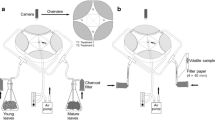Summary
Various butterflies select young foliage on which to lay their eggs; volatiles emitted by young and old leaves have been compared (by sorption enrichment, followed by GC-MS) to gauge possible qualitative and quantitative differences between the two age groups. The plants investigated are cabbage (Brassica oleracea), two milkweeds (Asclepias syriaca andA. curassavica), the bitter orange (Citrus aurantium) and the lime (C. aurantiifolia). The chemical compounds identified belong to three classes, isoprenoids, fatty acid derivatives and benzenoids. Quantitative differences were found between young and old leaves, of which a few may be characteristic of young leaves only. Thirty-four single trials withDanaus plexippus exposed to volatiles from young and old leaves are recorded.
Similar content being viewed by others
References
Agelopoulos NG, Keller MA (1994) Plant-natural enemy association in tritrophic system,Cotesia rubecula —Pieris rapae — Brassicaceae (Cruciferae). III: Collection and identification of plant and frass volatiles. J Chem Ecol 20:1955–1967
Baur R, Feeny P (1992) Comparison of electroantennogram responses by females of the black swallowtail butterfly,Papillio polyxenes, to volatiles from two host plant species. Pp 122–124in Menken SBJ, Visser JH, Harrewijn P (eds) Proc 8th Int Symp Insect-Plant Relationships. NL-Dordrecht: Kluwer Academic Publ
Bernays EA, Chapman RF (1994) Host-plant Selection by Phytophagous Insects. New York, London: Chapman & Hall
Blaakmeer A (1994) Plant response to eggs vs host marking pheromone as factors inhibiting oviposition byPieris brassicae. Pp 61–68in Infochemicals in a Tritrophic System. Ch. 5
Boland W, Gäbler A (1989) Biosynthesis of homoterpenes in higher plants. Helv Chim Acta 72:247–253
Chew FS, Renwick JAA (1995) Host plant choice inPieris butterflies. Pp 214–238in Cardé RT, Bell WS (eds) Chemical Ecology of Insects 2. New York, London: Chapman & Hall
Feeny P, Städler E, Âhman I, Carter M (1989) Effects of plant odor on oviposition by the black swallowtail butterfly,Papillio polyxenes (Lepidoptera: Papilionidae). J Insect Behav 2:803–827
Haribal M, Renwick JAA (1996) Oviposition stimulants for the monarch butterfly: flavonol glycosides fromAsclepias curassavica. Phytochemistry 41:139–144
Ilse D (1937) New observations on responses to colours in egg-laying butterflies. Nature 140:544–545
Ives PM (1978) How discriminating are cabbage butterflies? Australian J Ecol 3:261–276
Jones RE (1991) Host location and oviposition on plants. Pp 108–138in Bailey WJ, Ridsdill-Smith J (eds) Reproductive Behaviour of Insects. New York, London: Chapman & Hall
Kaiser R (1991) Trapping, investigation and reconstitution of flower scents. Pp 213–250in Müller PM, Lamparsky D (eds) Perfumes: Art, Science and Technology. NL-Amsterdam: Elsevier
Kirby W, Spence W (1860) An Introduction to Entomology. Lett X1. GB-London: Longman Roberts & Green
Myers, JH (1985) Effect of physiological condition of the host plant on the ovipositional choice of the cabbage white butterfly,Pieris rapae. J Anim Ecol 54:193–204
Nishida R (1990) Flavonoid-mediated host recognition by swallowtail butterflies. Proc 3rd Inter Symp on Flavonoids in Biology and Medicine 1989:199–212
Nishida R (1995) Oviposition stimulants of swallowtail butterflies. Pp 17–26in Scriber M, Tsubaki Y, Lederhouse C (eds) Swallowtail Butterflies. Gainesville/FL: Scientific Publ
Renwick JAA, Chew FS (1994) Oviposition behaviour in Lepidoptera. Annu Rev Entomol 39:377–400
Rothschild M (1987) Speculations concerning the large white butterfly (Pieris brassicae L): do the females assess the number of suitable host plants present? Pp 175–192in Chapman RF, Bernays EA, Stoffolano JG jr. (eds) Perspectives in Chemoreception and Behaviour. New York: Springer Verlag
Rothschild M, von Euw J, Reichstein T, Smith DAS, Pierre J (1975) Cardenolide storage inDanaus chrysippus (L). with additional notes onD. plexippus. Proc R Soc Lond B 190:1–31
Rothschild M, Schoonhoven LM (1977) Assessment of egg load byPieris brassicae (Lepidoptera: Pieridae). Nature 266:352–355
Rothschild M, Alborn H, Stenhagen G, Schoonhoven LM (1988) A strophanthidin glycoside in Siberian wallflower: a contact deterrent for the large white butterfly. Phytochemistry 27:101–108
Stahl-Biskup E, Intert F, Holthuijzen J, Stengele M, Schulz G (1993) Glycosidically-bound volatiles-a review 1986–1991. Flavour & Fragrance J 8:61–80
Takabayashi J, Dicke M, Takahashi S, Posthumus MA, van Beek TA (1994) Leaf age affects composition of herbivore-induced synomones and attraction of predatory mites. J Chem Ecol 20:373
Tollsten L, Bergström G (1988) Headspace volatiles of whole plants and macerated plant parts ofBrassica andSinapis. Phytochemistry 22:2073–2077
Tyler HA, Brown KS jr, Wilson KH (1994) Swallowtail Butterflies of the Americas: a Study in Biological Dynamics, Ecological Diversity, Biosystematics, and Conservation. Gainesville/FL: Scientific Publishers
Urquhart FA (1960) The Monarch Butterfly. University of Toronto Press
Urquhart FA (1987) The Monarch Butterfly: International Traveller. University of Toronto Press
Visser JH (1986) Host odor perception in phytophagous insects. Annu Rev Entomol 31:121–144
Woolfson A, Rothschild M (1990) Speculating about pyrazines. Proc R Soc Lond B 242:113–119
Author information
Authors and Affiliations
Rights and permissions
About this article
Cite this article
Bergström, G., Rothschild, M., Groth, I. et al. Oviposition by butterflies on young leaves: Investigation of leaf volatiles. Chemoecology 5, 147–158 (1994). https://doi.org/10.1007/BF01240599
Issue Date:
DOI: https://doi.org/10.1007/BF01240599




